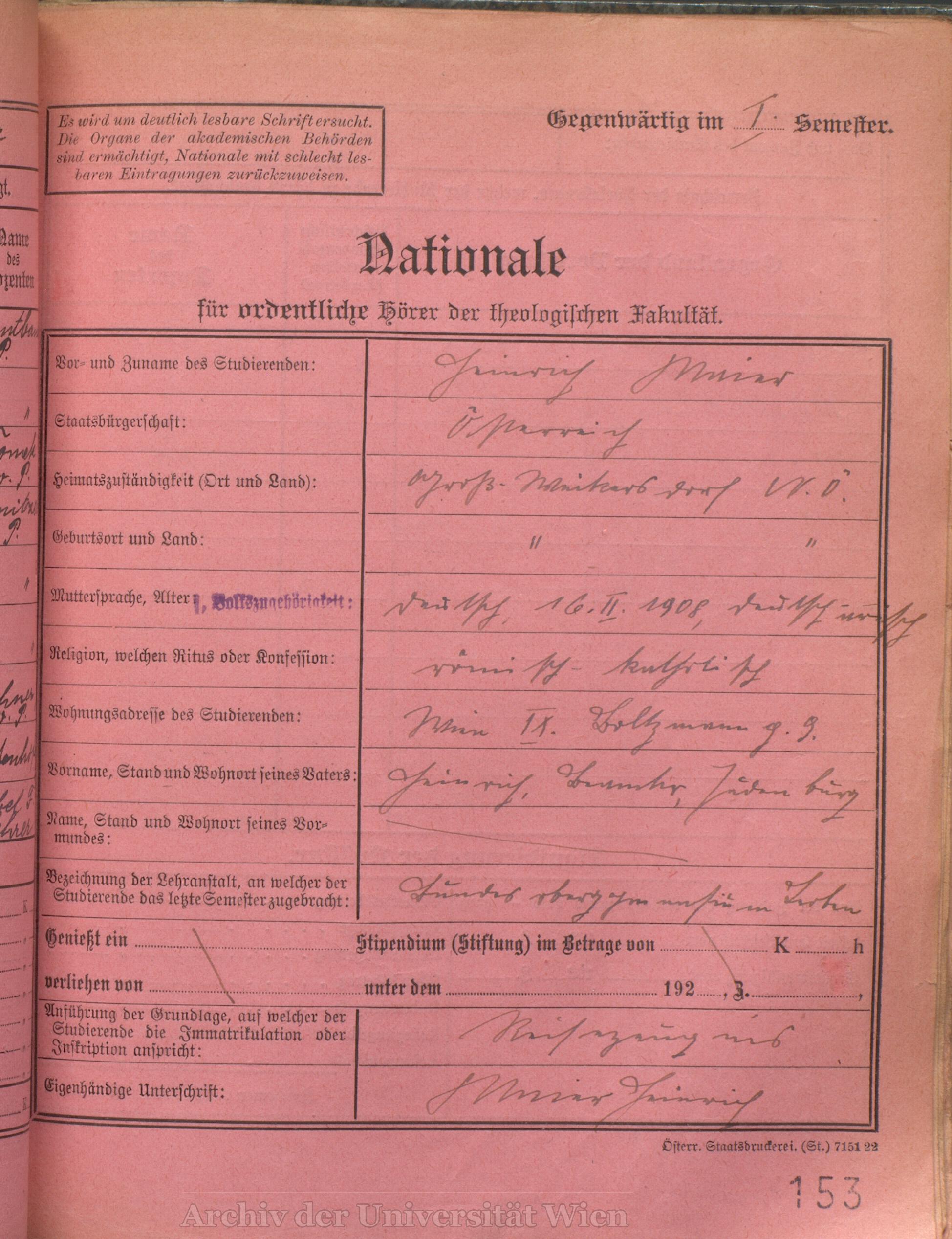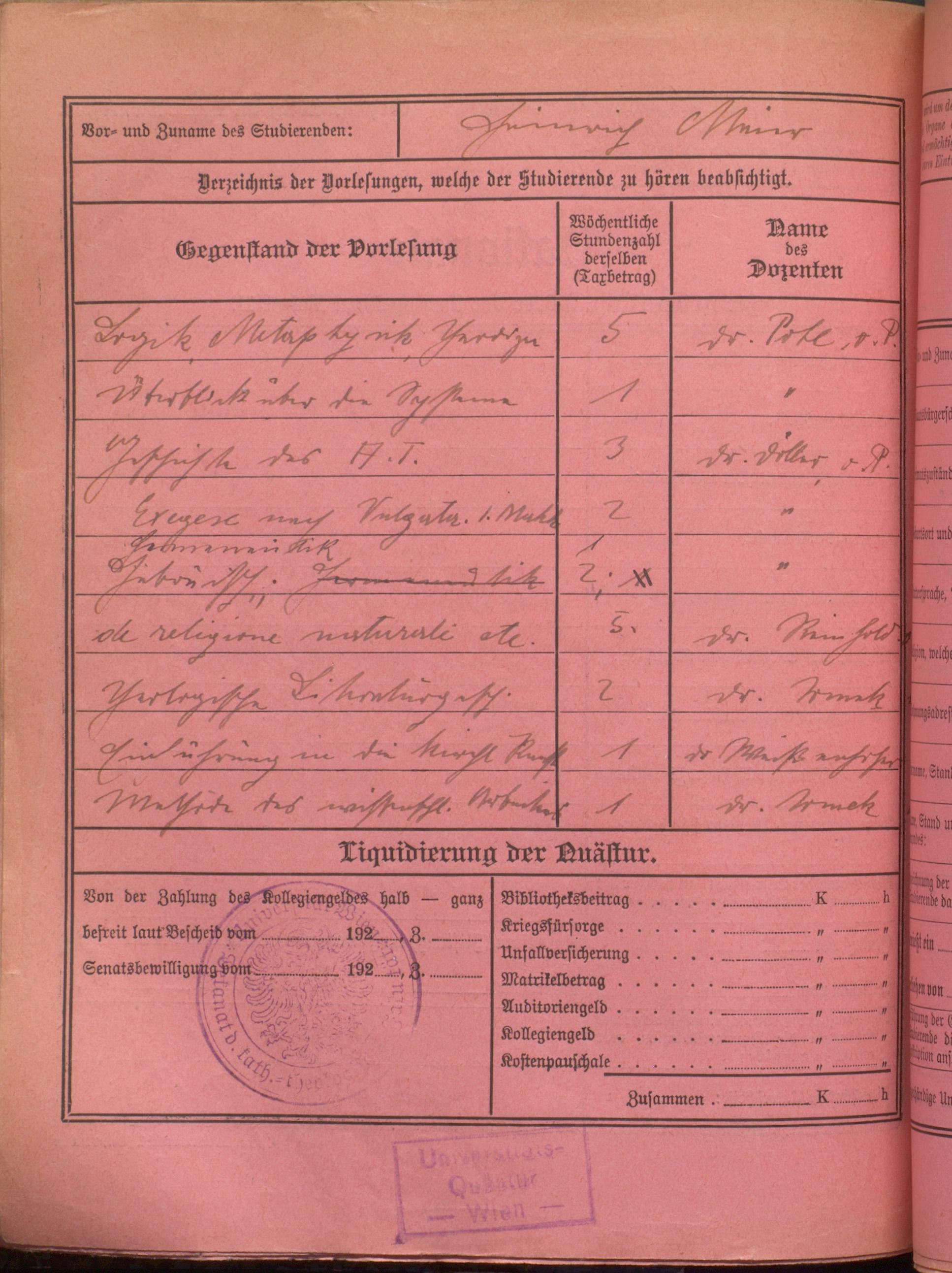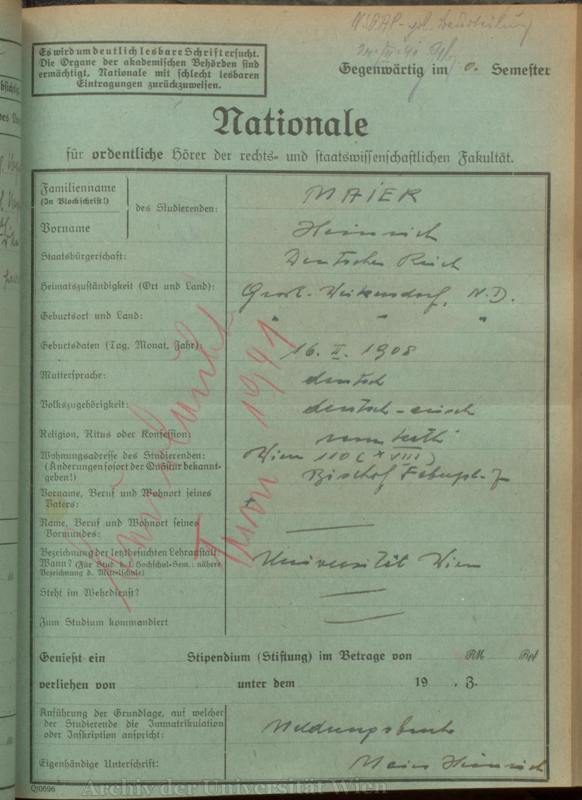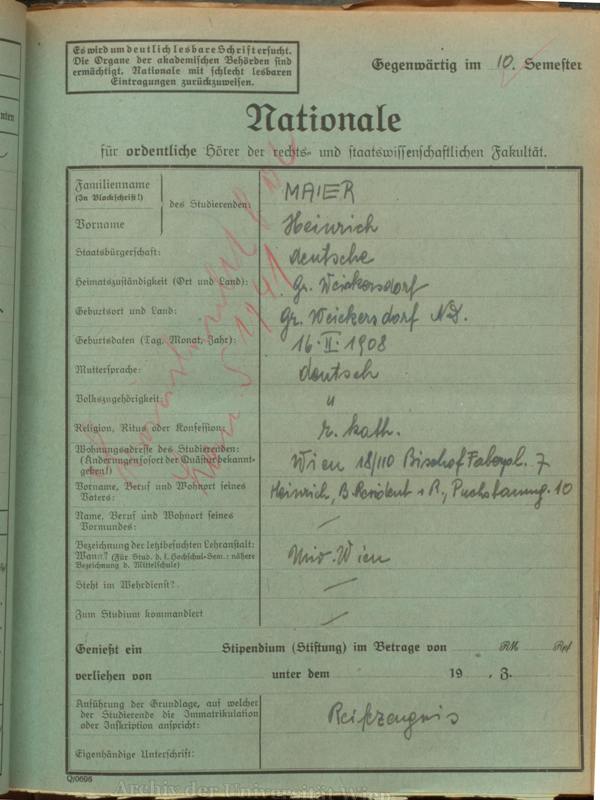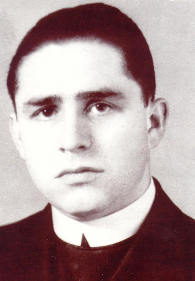
| Born: | 02-16-1908 |
| Faculty: | Law School |
| Category: | Expelled student |
Heinrich MAIER, born on February 16th, 1908 in Grossweikersdorf/Lower Austria (entitled residency ("heimatberechtigt") for Grossweikersdorf/Lower Austria, citizenship 1938: Austria), son of Heinrich Maier (former railway official) and Katharina Maier, née Giugno. The family moved several times following his father's employment. Heinrich Maier therefore attended the grammar school in St. Pölten from 1918 and the one in Leoben from 1926, where he also graduated in June 1926.
He entered the seminary on October 9th, 1926 and enrolled at the Roman Catholic Theological School of the University of Vienna in the fall term of 1926/27. After two years, he transferred to the "Pontificium Collegium Germanicum et Hungaricum" at the Pontifical Gregorian University in Rome in the fall of 1928, where he studied scholastic philosophy until 1929 (fellow student: Franz König, later Cardinal Archbishop of Vienna) and received his doctorate on July 16th, 1930. He returned to Vienna, resumed his theological studies from the fall term of 1930/31 to the spring term of 1932 (abs. theol. 1932) and initially lived in Vienna's 19th district, Silbererstrasse 35, later in the Aluminat in Vienna's 9th district, Boltzmanngasse 9.
He was ordained a priest on July 24th, 1932 and became a pastor in Lower Austria (from October 1932 in Schwarzau im Steinfeld, then in Reichenau, from September 1934 in Mödling). On September 1st, 1935, he became a deacon in the parish of Vienna-Gersthof and studied at the School of Law in 1935/36. From October 1935 he lived in Vienna's 18th district, Bischof-Faber-Platz 7. From 1936 he was also a religion teacher (teaching examination 1938) at the Federal Technical and Industrial College in Mödling and later at the Albertus-Magnus-Gymnasium of the Marienbrüder (Vienna's 18th district, Semperstraße).
With the abolition of religious education, Heinrich Maier lost his job as a teacher in 1938, but remained chaplain in the parish of Vienna-Gersthof-St. Leopold. From the fall term of 1938/39 to the spring term of 1941, he again devoted himself to studying law (trimester 1941 and spring term 1941 "on leave") and wrote his dissertation at the Catholic Theological School of the University of Vienna as early as 1939 (dissertation: "Der Kampf um den richtigen Kirchenbegriff im Spätmittelalter. Depicted on the basis of Marsilius of Padua's 'Defensor Pacis' and Johannes von Torquemada's 'Summa de Ecclesia'"). A few weeks after submitting and approving his dissertation, he passed the first viva in moral and pastoral theology on July 6th, 1939, the second viva in biblical studies on June 25th, 1941 and finally the third viva in dogmatic theology on July 16th, 1942. On July 25th, 1942, Maier received his doctorate in catholic theology.
He had already made his first contacts with resistance fighters in 1940. He was conscripted in 1941 and found "fit for military service", but was exempted from active military service. Until his arrest by the Gestapo in 1944 and contrary to Cardinal Innitzer's instructions to the priesthood to refrain from political involvement and to limit themselves to pastoral duties, he made contact with German resistance groups and Catholic trade unionists such as Jakob Kaiser in May/June 1940, who in turn maintained contact with Christian-social resistance fighters such as Felix Hurdes, Lois Weinberger and also with opponents of the regime such as Adolf Schärf and Karl Seitz. His comrade-in-arms, the Tyrolean Franz Josef Messner, General Director of the Semperit rubber works in Traiskirchen, Lower Austria, which was important to the war effort, was a profound expert on the war economy and had connections to domestic and foreign industry. The "Maier-Messner-Caldonazzi" group differed from other resistance groups in the way it worked, with only a few, mostly intellectual personalities belonging to it from 1943 onwards who were able to put their skills to the test. The inner circle included Dr. Helene Sokal and her later husband, the chemist Dr. Theodor Legradi, who had international connections, including to the communist resistance, the physician Dr. Josef Wyhnal and the student Hermann Klepell. The latter had connections to socialist circles, while another member, the communist Pawlin, established links with the Communist Party. "Maier-Messner" was supported by members of the independent resistance group around the Tyrolean resistance fighter engineer Walter Caldonazzi. Among other things, the group was responsible for collecting and passing on information about the locations, employees and production of Nazi armaments companies to the Allies. However, the plan to bring an American transmission system of the Office of Strategic Services (OSS) from Liechtenstein to Austria failed.
The group members were arrested one by one - Maier on March 28th, 1944 in the church of the Gersthof parish and was taken into Gestapo custody at Morzinplatz. Maier spent his time in custody studying English and French. He was transferred to the Vienna I remand prison on September 16th, 1944, charged by the People's Court on October 28th, 1944 with "establishing contact with the enemy abroad" and "betraying site plans of German armaments factories abroad in order to bring about air raids by the enemy on German armaments factories" and subsequently sentenced to death for "preparation for high treason" by "participating in a separatist association".
From the verdict of the People's Court, October 28th, 1944:
"In 1942 the defendant Maier believed that he could foresee with certainty the defeat of Germany in the present war. He was in fairly active contact with the divorced wife of an emigrated Jewish Viennese lawyer, Mrs. Sokal-Myrna. [...] They decided to contact the Western powers in good time in order to enter into talks with them. Maier wanted to demonstrate to the enemy abroad that a movement hostile to National Socialism already existed in the former Austrian lands, which could be reckoned with if necessary. Therefore, when Sokal travelled to Switzerland in 1942 - it remains unclear how she managed to obtain official permission to do so given her political background and as the wife of an emigrated Jew - she, in agreement with Maier, delivered a message written by Maier to the former Jesuit priest Dr. Karrer, who lived in Lucerne, with the following wording:
The common suffering has bridged the differences in the Austrian people. The parties, whether right or left, find themselves on a common platform. They affirm an independent, democratic Austria. We are ready to take our place in the reorganized family of nations of Europe in the post-war period and await your call as soon as the hour has come.
Sokal memorized these sentences and communicated them orally to Dr. Karrer, who promised to pass them on to the English ambassador in Bern. [...]
A number of people soon gathered around the accused Maier who agreed with his political views and, like him, were determined to contribute to the re-establishment of an independent Austrian state. This was to have a monarchist form of government and include Bavaria and South Tyrol in addition to the Austrian lands."
On November 22nd, despite the death sentence, he was transferred to the Mauthausen concentration camp in order to obtain more information about the group before his execution.Cardinal Innitzer sent a petition for clemency to Berlin and intervened with the Apostolic Nuncio in Berlin and the Commissioner of the Fulda Bishops' Conference. Innitzer's petition was unsuccessful, as were the pleas for clemency from university professor Ernst Schönbauer and Maier's mother.On March 18th, 1945, he was brought back to Vienna together with Messner, where he was beheaded on March 22nd, 1945 in the Vienna Provincial Court in Vienna 1, Landesgerichtsstraße 11.
In 1945 he was given an honorary grave in the cemetery in Neustift am Walde (Vienna), in 1949 Dr. Heinrich Maier-Straße was named after him in Vienna's 18th district (an additional plaque was added in 1995), in 1988 a memorial plaque was placed on the Gersthof rectory, and he is commemorated in the memorial of the Catholic Couleur students in Vienna's 8th district, Lerchenfelderstrasse 14 (he was a member of the Catholic student fraternity K.Ö.St.V. Nibelungia in the Austrian Cartell Association (ÖCV)), in 1995 a memorial plaque was placed at Dr. Heinrich Maier-Straße 1 and in 1996 a tree was planted in his honor in front of the Gersthof-St. Leopold parish church.
Hans Schwabenicky created a wooden sculpture "Der Kopflose" (Chaplain Heinrich Maier statue) for the Gersthof church, the composer Gerald Spitzner dedicated the "Heinrich-Maier Oratorio" to him, which was premiered in 1995 at the place of execution (Vienna Provincial Court).
Lit.: Archive of the University of Vienna/enrollment forms ("Nationale") Roman-Catholic-Theolological School 1926–1930 ans Law School 1935–1941, final examination registry ("Rigorosenprotokoll") Roman-Catholic-Theolological School 1919–1946, ThK 41.6, No 307, graduation registry ("Promotionsprotokoll") Roman-Catholic-Theolological School, Vol. 1, No 846 (July 25th, 1942); Information from Meldearchiv/Vienna City Archive, 22.07.2014; KNIEFACZ/POSCH 2017a; Ursula Rumpler: MAIER, Heinrich. In: Biographisch-Bibliographisches Kirchenlexikon (BBKL). Band 27, Nordhausen 2006, Sp. 885–899; DÖW 1998, 63, 68, 173, 176–177, 193, 366, 369–370, 373;
Gedenkseite Pfarre Gersthof; WIKI; DÖW; H. MADER, Maier DDr. H., in: Karl-von-Vogelsang-Institut (ed.), Gelitten für Österreich, 1988; Gerhard JAGSCHITZ, Kaplan DDr. Heinrich Maier, in: Hundert (100) Jahre Nibelungia. Festschrift zum hundertsten Stiftungsfest der Katholisch-Österreichischen Studentenverbindung Nibelungia zu Wien im ÖCV. Vienna 2008, 25–30; Jacob FRIED, Nationalsozialismus und katholische Kirche in Österreich, Vienna 1947, 1948²; Herbert STEINER, Gestorben für Österreich, Widerstand gegen Hitler. Eine Dokumentation, Vienna-Frankfurt-Zurich 1968; Benedicta Maria KEMPNER, Priester vor Hitlers Tribunalen, Munich 19661, 263; 1967², 65; DÖW (ed.), Erzählte Geschichte, Berichte von Männern und Frauen in Widerstand wie Verfolgung, Vol. 2: Katholiken, Konservative Legitimisten, Vienna 1992; DÖW (ed.), Widerstand und Verfolgung in Wien, 1934–1945. Eine Dokumentation Vol. 1–3, Vienna 1975, 188 ff.; DÖW (ed.), Widerstand und Verfolgung in Wien 1938–1945, Vol. 3, Vienna 1984, 75, 81, 118 ff.; Anton HECHT, Norbert RAUCH & Norbert RODT, Geköpft für Christus & Österreich: DDr. Heinrich Maier, Kaplan in Wien-Gersthof, Unterrichtsimpuls, Vienna 1996; Österreichischer Verein für Studentengeschichte (ed.), Farben tragen – Farbe bekennen, 1938–1945, Katholische Korporierte in Widerstand und Verfolgung, Vienna 1988, 106–107, 133 (2013², 418ff.); Siegfried BEER, "Arcel/Cassia/Redbird". Die Widerstandsgruppe Maier-Messner und der amerikanische Kriegsgeheimdienst OSS in Bern, Istanbul und Algier 1943–1944, in: DÖW (ed.): Jahrbuch 1993, Vienna 1993, 75–100; Norbert RODT, Anton HECHT & Ernst DEGASPERI, Zeugnis der Auferstehung. Dokumente und Bilder aus dem Leben des Priesters Heinrich Maier, Innsbruck 1995; Erika WEINZIERL, Katholische Priester im Widerstand, in: M. Liebmann, H. Paarhammer & A. Rinnerthaler (ed.), Staat und Kirche in der "Ostmark", Frankfurt am Main, Vienna (u.a.) 1998, 473–500.
Katharina Kniefacz and Herbert Posch
